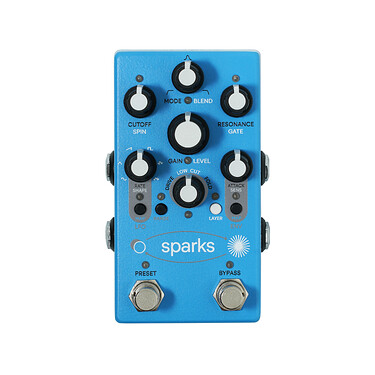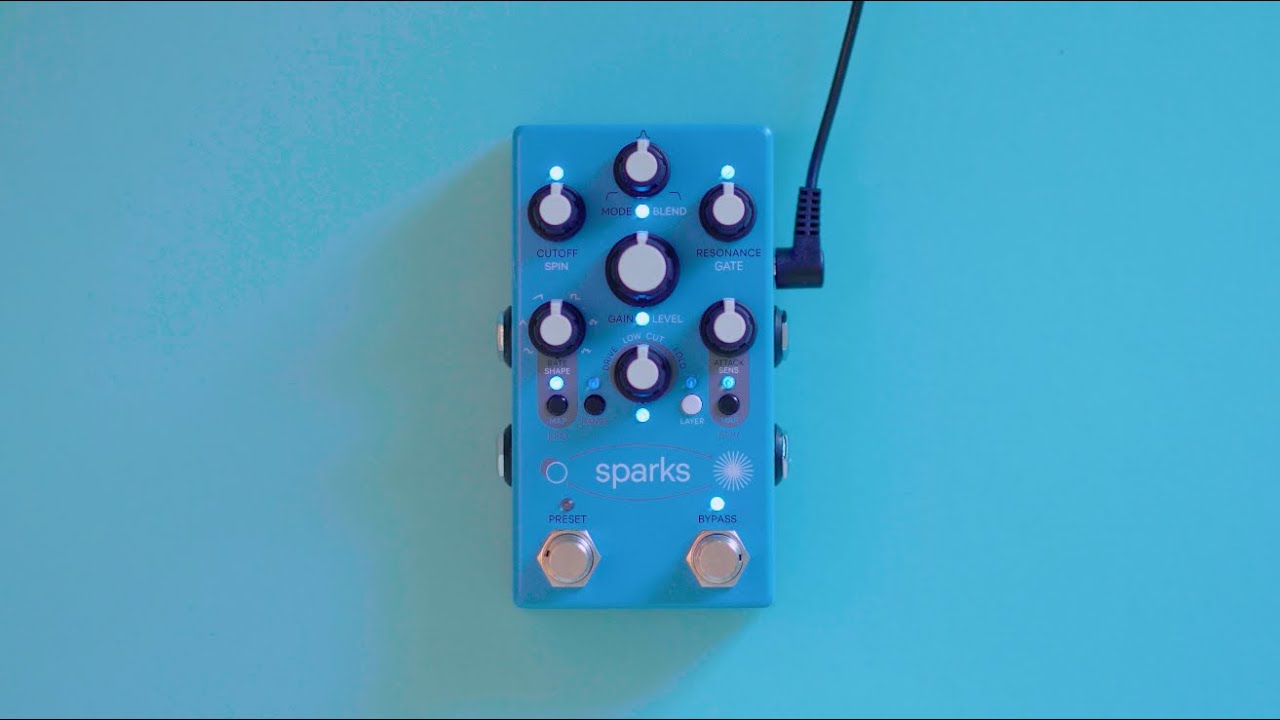Here is a video introduction to Sparks:
I wanted to share some backstory here about how and why I made this thing.
I’ve been chipping away at Sparks since we launched Ribbons in the fall of 2022. At first I thought it would be a simple project that would come together quickly, but fast forward to now, it took longer than I ever imagined and was probably the hardest work I’ve ever done. It was also hugely rewarding and taught me lessons I could only learn by experimenting and refining the design. I did 7 revisions of the PCB until I was happy with it.
Sparks is the compact drive I always wanted. My goal was to create a stereo drive that could shape-shift and sound equally great on guitar, bass, drums, or full mixes. Not an easy task, but with the right utilities surrounding the drive, I found a way to achieve it.
The Drive and Filter:
I spent a lot of time studying circuits that I liked and found that the key to a great drive is the pre and post-drive tone shaping controls. The most important ingredient in the pre-control is the low-cut filter, especially when playing complex chords on guitar. But - having the option to dial this back when running bass, drums, or full mixes through it is essential, so I made it variable.
For the clipping section I picked two extremes - a pleasant soft clipping circuit with zener diodes and an aggressive Serge-style wavefolder with the option to crossfade between them. My take on the Serge wavefolder is somewhat unique - I managed to squeeze twice as many folds out of a typical folding stage, which achieves an incredible sound in a small amount of space.
For the post-tone control, I wanted something musical but not too surgical, so I chose a filter topology from my favorite synthesizer - the Oberheim SEM, which gives you high-pass, band-pass, and low-pass outputs, letting you hone in on the harmonic content you want to emphasize while also having resonance. I feel a special connection with the SEM because I restored an Oberheim Four Voice (made up of four SEM modules) 6 or so years ago. It was found abandoned in an apartment and filled with bullet holes - it was a complete wreck. But after restoring it, it was one of the most beautiful sounding instruments I’ve ever heard. The SEM is very pure/vanilla when it goes into resonance though so I added another soft clipping section afterward that adds some extra harmonic content to it, making it growl like an MS-20 when the resonance is cranked.
Finally, I added the ability to blend the dry signal with the distorted/filtered signal, to help add back in some clarity and dynamics when the gain is high. I also threw in a gate in case you end up getting a little noise or feedback on the stage or in the studio.
Adding Motion to Things:
After discovering a great recipe for the analog section, I really wanted to add motion to things. Not just vertical motion (turning a parameter up and down) but also horizontal motion (stereo). So I added an LFO and an envelope follower. The LFO morphs smoothly between waveforms (no clicks or jumps), goes well into audio rate in case you want to get weird, and can add variation to the stereo field using the SPIN control. The envelope follower has 3 modes: classic, which started as an emulation of the ARP 2600 envelope follower but ended up being tweaked into something more useable. Compressor, which emulates compressor side chains and takes inspiration from Ribbons compressor, which itself was inspired by the SP-303’s Vinyl Sim compressor. And AR, which emulates the auto-swell effect found in devices like Slow Gear and Attack Decay.
The combination of the LFO/ENV and the DRIVE/FILTER turns Sparks into a powerful analog toolkit capable of compression, auto-wah, auto-swell, tremolo, harmonic tremolo, audio rate amplitude modulation that sounds like a ring-mod, and many other uncharted possibilities.
The SID chip synth
My favorite music group of all time is the late and great Broadcast. From Work and Non Work, to their Microtronics experiments, and their soon to be released Spell Blanket/Distant Call, I’ve always felt a deep connection with their music. On their 2005 release, they made heavy use of a VST plugin called QuadraSid by ReFx, which was an emulation of the SID chip from the Commodore 64. It’s one of the center pieces of tracks like Black Cat and I Found the F.
So… why emulate it for Sparks? Well… it just felt like a perfect opportunity. The SID chip architecture consists of digital oscillators injected into an analog state variable filter (same filter topology as the Oberheim SEM). All I had to do was re-create the oscillators and envelopes and we’d have a really great emulation of a SID chip. So I rolled up my sleeves and tried my best to re-create it from scratch using information I could find on the web. An interview with the SID chip designer Bob Yannes provided me with almost all the info I needed and then I was able to fill in the missing pieces of information from discussions on the 6502.org site. I’m really happy with the result and am having a blast emulating my favorite synth patches from Tender Buttons.
As a bonus: some feature requests from our beta testing team have turned this thing into a powerful techno acid-machine that is great at emulating the sounds of the TB-303.
Huge Thanks
To my partner Hannah for helping me turn this crazy idea into a focused and intuitive device, to our beta testers for their brilliant and thoughtful feedback, to my friend John Snyder from EAE whose advice and guidance helped me unturn every stone and elevate this design from noisy prototype to a polished and well-engineered tool, and to our friend Pat Horigan for helping us showcase Sparks by making some great music with it. Finally, thank you to all of our amazing users. We couldn’t keep Kinotone going without your support.

